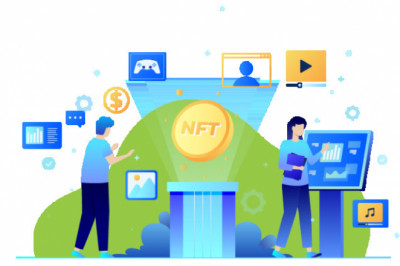views
The growth of financial technology—or fintech—has been nothing short of remarkable. In fact, its revenues will grow three times faster than traditional banking in 2028. With each passing year, the adoption of fintech solutions is only making financial institutions (FI) more accessible to businesses in need of funding.
What does it mean for you? Let's examine what makes fintech possible and its endless applications, focusing on business-to-business (B2B) lending. You can use this information to inform your decision-making processes and strengthen your operations in an increasingly digitized financial ecosystem.
What is Fintech?
Fintech refers to technology that delivers financial services and products more efficiently, conveniently, and cost-effectively through digital means. Fintech in B2B lending, in particular, offers digital platforms for originating and servicing loans, among other operations. They also leverage data analytics to assess creditworthiness and expedite loan approvals.
4 Technologies That Enable Fintech in B2B Lending
Fintech doesn't exist in a vacuum. Instead, it uses the following technologies—and more—to improve B2B lending processes and other financial operations.
1. Artificial intelligence (AI)
AI is storming many industries and market segments, including B2B lending. Machine learning allows AI to analyze large amounts of data to assess creditworthiness more accurately and efficiently than traditional methods. It also elevates the user side: AI-powered chatbots provide borrowers with round-the-clock personalized assistance for simple to intermediate inquiries.
2. Blockchain technology
Security is a critical concern in finance, and nowhere is it more upheld than in blockchain. This tech provides a decentralized and immutable ledger for recording transactions, making loans easily verifiable among concerned parties. Blockchain-enabled smart contracts also automate loan agreements to eliminate vulnerable intermediaries and cut down wait times.
3. Cloud computing
Working on the cloud allows B2B lending operations to scale and remain agile despite fluctuating demands. It also provides a centralized repository for data, thereby reducing the need for extensive IT hardware infrastructure and enabling real-time access and verification among borrowers and lenders.
4. Big data analytics
Say goodbye to the time and resource-intensive task of organizing and analyzing heaps of data. Big data analytics enables systems to rapidly scan borrower data to gain deeper insights into behaviors and credit risks. Additionally, predictive analytics models identify patterns and correlations, allowing lenders to tailor loan products to each business's specific needs.
How do Financial Institutions Leverage Fintech in B2B Lending?
What does fintech look like in practice? Here are some real-world use cases that modernize the finance landscape.
Online loan applications
Businesses no longer have to fill out paper-based forms and process them manually. Today, online loan applications allow them to submit requirements digitally via a website or mobile app, reducing the need for human representatives.
Numerous FIs have long used online loan applications for B2C and B2B transactions. Take American Express, for example. You can apply for a business line of credit online and get reviewed in real time, so you won't have to travel to a physical office, fill out lengthy forms, and go through a tedious application process.
Data-driven risk assessments
B2B lending companies can now use advanced analytics and machine learning to evaluate creditworthiness. It lets them tailor loan terms to the specific risk profiles of borrowers and mitigate their losses from defaulting clients.
Most FIs utilize fintech to streamline their approval processes. Analyzing bank transactions, online sales data, and other data sources enables them to rapidly assess applicants' creditworthiness in real time, significantly improving their sales velocity.
Fraud detection and prevention
Finance revolves around security. After all, it deals with people's data and hard-earned money; failure to implement security measures could lead to lawsuits or worse. Fortunately, fintech uses pattern recognition techniques to flag suspicious activities in B2B lending transactions. As a result, creditors can more easily mitigate risks and protect themselves and their borrowers.
Onfindo is a popular choice among well-established FIs. This digital security company leverages AI-powered identity verification to prevent scams, eliminating 93% of fraudulent accounts and improving conversions by 48% for MACH, an all-around financial service provider.
Pros and Cons of Fintech Adoption
As much as fintech offers numerous benefits to FIs and borrowers, it also raises some concerns that warrant further consideration. Let’s weigh its pros and cons below to help you understand it better.
Pros
Fintech streamlines loan approvals and disbursements by automating manual processes. It leads to lower operational costs since there's minimal need for physical infrastructure and manual labor. Furthermore, fintech's ability to leverage big data analytics means creditors can assess creditworthiness more accurately, reducing the likelihood of defaults.
Cons
The primary concern with any industry leveraging AI and automation is job security, as there's less need for human workers. Moreover, delegating sensitive information to computer systems makes them more vulnerable to cyberattacks and data breaches. Compliance with data protection regulations, like the EU's General Data Protection Regulation (GDPR), further complicates finance operations.
The Future of Finance
Integrating fintech in B2B lending operations opens opportunities and challenges for FIs and fintech companies. While it boosts efficiency and risk management within the segment, it poses concerns that might undermine its benefits.
As such, the future of B2B lending rests on stakeholders leveraging each other's strengths to create a more competitive and innovative financial landscape. FIs and loan consultants can bring tech expertise and regulatory compliance to the table, while fintech companies can provide cutting-edge technology and agility. This partnership may produce more innovative solutions that drive growth in B2B lending.











